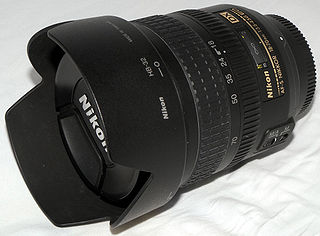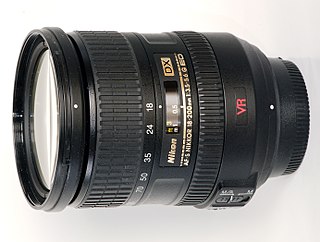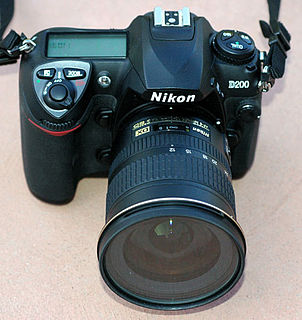
Nikon Corporation, also known just as Nikon, is a Japanese multinational corporation headquartered in Tokyo, Japan, specializing in optics and imaging products. The companies held by Nikon form the Nikon Group.

The Nikon F-mount is a type of interchangeable lens mount developed by Nikon for its 35mm format single-lens reflex cameras. The F-mount was first introduced on the Nikon F camera in 1959, and features a three-lug bayonet mount with a 44 mm throat and a flange to focal plane distance of 46.5 mm. The company continues, with the 2020 D6 model, to use variations of the same lens mount specification for its film and digital SLR cameras.

The Nikon DX format is an alternative name used by Nikon corporation for APS-C image sensor format being approximately 24x16 mm. Its dimensions are about 2⁄3 those of the 35mm format. The format was created by Nikon for its digital SLR cameras, many of which are equipped with DX-sized sensors. DX format is very similar in size to sensors from Pentax, Sony and other camera manufacturers. All are referred to as APS-C, including the Canon cameras with a slightly smaller sensor.

The AF-S DX Zoom-Nikkor 18-70mm f/3.5-4.5G ED-IF is an F-mount zoom lens manufactured and sold by Nikon. Designed exclusively for use on Nikon DX format cameras, this lens covers from wide-angle to medium-telephoto range.

The Nikon D700 is a professional-grade full-frame digital single-lens reflex camera introduced by the Nikon Corporation in July 2008 and manufactured in Japan. It uses the same 12.1-megapixel "FX" CMOS image sensor as the Nikon D3, and is Nikon's second full-frame digital SLR camera.

The Nikon AF-S DX VR Zoom-Nikkor 18-200mm f/3.5-5.6G IF-ED is an image stabilised superzoom lens manufactured by Nikon for use on Nikon DX format digital SLR cameras. It provides a single-lens "walk-around" solution for wide-angle through to telephoto shots, as well as close-up photography.

The Nikon AF-S DX Nikkor 35mm f/1.8G is a lens manufactured by Nikon for use on Nikon DX format digital SLR cameras. It provides a field of view on a DX format camera similar to that of a normal lens on a 35mm film format camera.

The AF-S DX Zoom-Nikkor 12-24mm f/4G is a lens manufactured by Nikon for use on Nikon DX format digital SLR cameras. It provides an angle of view on a DX format camera similar to that of an 18-35mm lens on a 135 film format camera.

The 18-55mm f/3.5-5.6G AF-S Zoom-Nikkor lens is a midrange zoom lens manufactured by Nikon for use on Nikon DX format digital SLR cameras. Often included as a kit lens on entry-level DSLRs, it also can be purchased separately from the camera body. Nikon first introduced the lens in 2005 and has provided three subsequent updates. Following are the four variants as of 2014:

The Nikon 105mm f/2.8G IF-ED AF-S VR is a macro prime lens produced by Nikon Corporation. It is compatible with FX sized sensors as well as DX format.

The Nikon D3100 is a 14.2-megapixel DX format DSLR Nikon F-mount camera announced by Nikon on August 19, 2010. It replaced the D3000 as Nikon's entry level DSLR. It introduced Nikon's new EXPEED 2 image processor and was the first Nikon DSLR featuring full high-definition video recording with full-time autofocus and H.264 compression, instead of Motion JPEG compression. It was also the first Nikon DSLR to provide high-definition video recording at more than one frame rate.

The AF-S DX Nikkor 18-105mm f/3.5-5.6G ED VR is a superzoom lens manufactured by Nikon, introduced in August 2008 for use on Nikon DX format digital SLR cameras. This lens is sold as a kit lens for the Nikon D90, Nikon D7000, Nikon D5100, Nikon D5200 and Nikon D3200 cameras, but it also can be purchased separately from the camera body.

The Nikon 1 series is a discontinued camera line from Nikon, originally announced on 21 September 2011. The cameras utilized Nikon 1-mount lenses, and featured 1" CX format sensors.

The Nikon AF-S Zoom-Nikkor 24-120mm f/4G IF-ED VR is a 5x Standard zoom lens with a fixed maximum aperture of f/4 throughout its entire zoom range.

The AF-S DX Nikkor 18-140mm f/3.5-5.6G ED VR is a superzoom lens manufactured by Nikon, introduced in August 2013 for use on Nikon DX format digital SLR cameras.
The 18-300mm f/3.5-6.3G lens is a telephoto superzoom lens manufactured by Nikon for its line of DX DSLR cameras.

The 55-300mm f/4.5-5.6G AF-S lens is a telephoto superzoom lens manufactured by Nikon for its line of DX DSLR cameras.

The AF-S DX Zoom-Nikkor 10-24mm f/3.5-4.5G ED is a lens manufactured by Nikon for use on Nikon DX format digital SLR cameras. It provides an angle of view on a DX format camera similar to that of a 15-35mm lens on a 135 film format camera.

Nikon Z-mount is an interchangeable lens mount developed by Nikon for its mirrorless digital cameras. In late 2018, Nikon released two cameras that use this mount, the full-frame Nikon Z 7 and Nikon Z 6. In late 2019 Nikon announced their first Z-mount camera with an APS-C sensor, the Nikon Z 50. In July 2020 the entry level full-frame Z 5 was introduced. In October 2020, Nikon announced the Nikon Z 6II and Nikon Z 7II, which succeed the Z 6 and Z 7, respectively. The APS-C lineup was expanded in July of 2021, with the introduction of the retro styled Nikon Z fc, and in October 2021, Nikon unveiled the Nikon Z 9, which effectively succeeds the brand's flagship D6 DSLR.

















